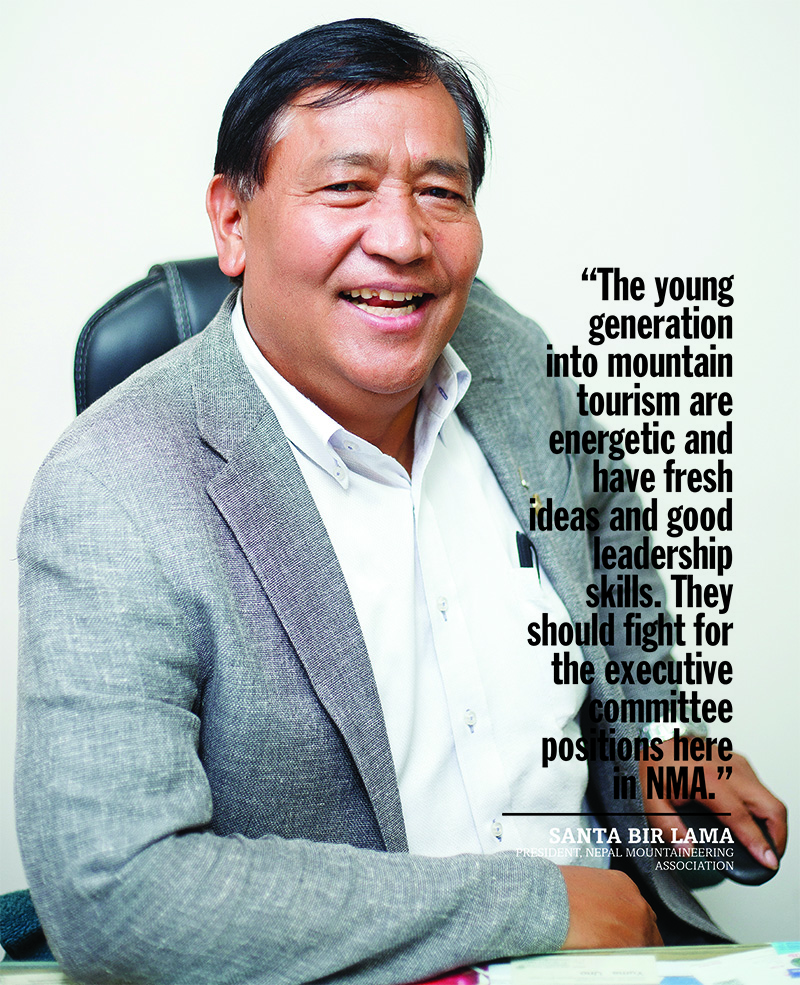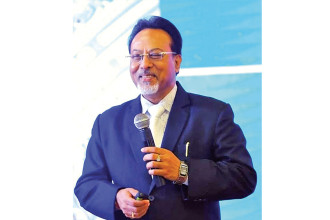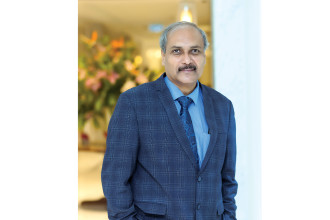
Santa Bir Lama
President, Nepal Mountaineering Association
Santa Bir Lama is the current President of Nepal Mountaineering Association (NMA). He started his journey with NMA as an Executive Board Member and became its President in August 2017.
Born in 1960 in Kavre, Lama started his career in trekking and mountaineering from the age of 13. He started as a porter, cook, logistic handler and guide, and in 1993 established his own company, Lama Adventure Treks and Expedition.
He was also Executive Committee Member of Trekking Agencies’ Association of Nepal (TAAN) during the Visit Nepal 1998 tourism campaign. Besides being professionally involved in mountain tourism, Lama is also socially active and has been contributing to build schools, colleges and hospitals in his home district.
Dibesh Dangol of B360 interviewed Lama to know about his achievements and plans for NMA, his views on Visit Nepal 2020, and issues regarding management of traffic, deaths, wastage and insurance scams hounding mountaineering tourism. Excerpts:
What are the activities NMA is involved in?
NMA was established in November 1973 as a non-government, non-profit and non-political organisation to work as a national alpine association of Nepal to promote mountain tourism, climbing sports, protect mountain environments and promote cultural heritage of mountain people.
Accordingly, NMA is currently providing training from basic to advance level and high mountain rescue training to the people and guides who are involved in mountaineering and climbing activities in Nepal. Till now NMA has conducted 40 training camps and continuity to this is being given at our training camp in Manang which is being remodelled and rebuilt with modern facilities with the support of Um Hong Gil Foundation. NMA has also been granting scholarships and sponsorship to members of deceased climbers and guides.
Two of the biggest projects NMA has continuously been working on are International Mountain Museum at Pokhara and International Mountaineer’s Memorial Park at Kakani. Continuity to upgrading both facilities with new information regarding mountaineering and history of passed-achieved climbers are being done.
NMA is also involved in women empowerment and we have been supporting women mountaineers for a long time. Also, NMA has been taking the waste issue in climbable mountains seriously and has been engaged in spreading awareness and cleaning programmes with concerned authorities and volunteers.
Can you provide us an update on opening climbing access to new mountains?
Nepal Government has given responsibility to NMA to make peak profiles of 414 mountains which will contain detailed information of the peaks and their surroundings. It can be used as a promotion mechanism for Visit Nepal 2020 tourism campaign and will be helpful for visitors who are planning to explore Nepal via trekking or mountaineering activities. Almost 80% of the work has been done and the rest will be completed soon. There are many small peaks which have obtained climbing access but management and promotions of such peaks aren’t being done. So, we have requested the government to give us access to manage and promote these peaks.
You were appointed as President of NMA in August 2017 and your tenure will end on August 2020. What were your agendas and what has NMA been able to achieve under your leadership?
Not just mine but also my entire committee members’ agendas were and still are to develop and introduce modern technologies for climbers’ training, promote mountain tourism globally through my personal and NMA’s channels, run NMA smoothly and effectively which was lacking before my term, and listen, encourage and put forward ideas of the new generation entrepreneurs involved in mountain tourism.
When running to become the President of NMA, I promised that the remaining allowances from my international visits will be given to social causes and welfare centres which I have been doing.
I have also suggested to board members and stakeholders of NMA to revise the regulations and policies of NMA regarding the candidate selection process for elections. In the past many retired people have held this office and have done nothing great. My suggestion is for the young generation who are into mountain tourism, and who are energetic and have fresh ideas and good leadership skills to fight for the executive committee positions here in NMA.
Another agenda was to bring out a new regulation and request Government of Nepal to provide Summit Certificate to the mountaineering guides which they have been deprived of in the past, and to renew 12 Group ‘A’ NMA expedition peaks which was to be renewed every five years, but wasn’t done. The renewing of NMA Peaks wasn’t accepted by the government in the past due to ill performance of NMA in the past. Now, both issues have been solved, and mountaineering guides who have summited Everest will also be getting Summit Certificate.
These works, which I and my team members have done, are for the benefit of mountain climbers, mountaineering expedition companies and the tourism industry of Nepal, and will be our focus until my term ends.
How is being a member of NMA beneficial?
There are no direct monetary benefits by becoming a member of NMA. If the members have clear and positive plans about developing mountaineering tourism in Nepal and want to implement these, they can share them with NMA and if the idea is feasible, NMA can implement those ideas. So, one of the biggest benefits is having ones plans implemented and taking pride in it. NMA is also affiliated with Union of International Alpinism Associations and Union of Asian Alpine Associations which means the members will have easy access to international markets via NMA.
To be an individual member of NMA, it is important for the person to be above 18 years, involved and have experience in mountain tourism sector. For associate membership, the company should be a trekking, travel and tourism related agency which works as a liaison point between mountaineers and NMA in issuing permit to climb any NMA peak. They will have to submit documents like application on company’s letter head, certificate from Office of Company Registrar, certificate from Office of Domestic and Small Scale Industries, certificate of Permanent Account Number (PAN), temporary permission letter to transact foreign currency issued from Nepal Rastra Bank and license issued from Tourism Industries Division to work as travel/trekking agency.

What plans does NMA have for Visit Nepal 2020?
NMA hasn’t been given the exact responsibilities of what we should do for the Visit Nepal 2020 tourism campaign by the people or institutions directly involved in the tourism campaign. But, since it is a national campaign, NMA has been promoting the tourism campaign through our mountaineering channels and international forums we are involved in. If both parties, NMA and Visit Nepal 2020 campaigners, can come together and collaborate and bring out ideas regarding what NMA needs to do to promote the tourism campaign, I think it will lead to better results and this needs to happen fast.
For Visit Nepal 2020, the focus should be on the quality of visitors rather than the quantity. The visitors who have greater spending capacity should be the target. Not just for the tourism campaign but NMA has been focusing on attracting quality visitors for a number of years now. Also, the tourism industry stakeholders including NMA and mountaineering companies should be focusing on creating new innovative tourism subsidies, activities and facilities, not just for VNY2020 but for future also, so that the visitors will indulge in more activities leading to greater spending.
What is NMA’s role in managing traffic, deaths and wastages on Mt. Everest and other peaks?
NMA is a focused institution on these issues because the government has given permission to us regarding issuing permits for 27 mountains. On April 14, NMA partnered and started a 45-day ‘Everest Cleaning Campaign’ with Coca-Cola in Nepal, Nepal Army, Sagarmatha Pollution Control Committee, and central, provincial and local governments which was a grand success. Similarly, to solve these issues, NMA will be collaborating with the local government, tourism officials, other government and non-government institutions time and again in the near future too.
Time and again there has been news surfacing in domestic and international media regarding insurance scam and fake rescues; what are your thoughts?
The main decision regarding this is to be taken by the government. The only thing NMA is able to do regarding this issue is identify, investigate and pass on the message to the government that such insurance and rescue companies are involved in such frauds and present the report after which the final decision rests upon the government or court’s hand. This issue was big and immediately needed to be solved two years back. But now, it has been completely solved and immediate necessary actions are being taken on companies who are involved in such frauds.
Global warming is a serious concern. In an interview with Nat Geo some months back, Kanchha Sherpa, the last surviving member of 1953 British Expedition Sherpa team, said “The tourism, it’s been good for the Sherpas… but it’s bad for the Gods. When I was a boy, there were many feet of snow in winter. Now, the summits are black. That’s not good.” How seriously is NMA taking this issue?
We are taking this topic seriously and the environment management department of NMA are regularly in talks with various NGOs and INGOs involved. We have been organising awareness programs around villages of 27 climbing permitted mountains regarding keeping surroundings clean and global warming. But, global warming isn’t just caused by surroundings of these snow-capped mountains; it is due to global waste and pollution. So, even though we solve environmental issues in and around these snow-capped mountains or in Nepal, it is just not enough. These issues needs to be taken and heard at international platforms mainly by the Nepal Government, media houses and also individually. It’s not just a responsibility of a single individual or institution. To seriously tackle and solve this issue, the main root of this problem needs to be cut down which I think won’t be happening anytime soon due to the industrial revolution going on around the world.
A weather station has successfully been installed on Mt. Everest. How will that help?
Since it is a weather station on Mt. Everest, it will surely help to provide real-time information about the weather condition at Everest to researchers, climbers and the public around that region. I have also read that it will continuously monitor the upper reaches of atmosphere to track and predict weather patterns around the world and help communities respond to climate risks around the Everest region which contains more than one billion people.
There are liaison officers assigned to mountaineering expeditions who are responsible to make reports regarding expeditions. This year on Everest, 33 officers were assigned but only 17 made it to the base camp. Rest couldn’t even make it to the base camp because of medical reasons. Also, they are paid between US$ 2500-3000 for an expedition. Why are unqualified people being appointed?
This is truly an alarming issue but it’s out of reach of NMA. The Department of Tourism is solely active in hiring these liaison officers and we don’t know why they are hiring such unqualified people. It might be due to their internal policies or due to other reasons.
NMA has been talking with Department of Tourism regarding this for a while now because issues regarding this have been reaching the international media and tarnishing our country’s reputation globally. As we can only give suggestions and don’t have any direct authority over them, we have suggested them to send their liaison officer candidates to our mountaineering training and get them certified and to see if they are able to pass through our training. Other suggestions we gave them are to consult us or ask us for certified mountaineers who can do the work of liaison officers also or to make the officers go through a medical check-up to see if they are competent or incompetent to do their job. So, the point is that we suggested them for collaboration.






